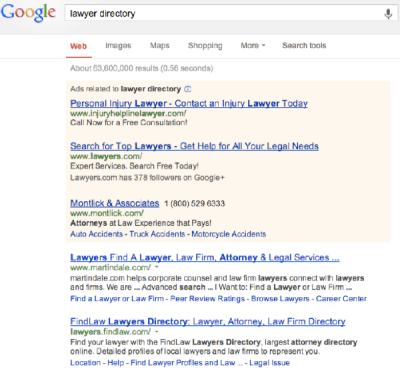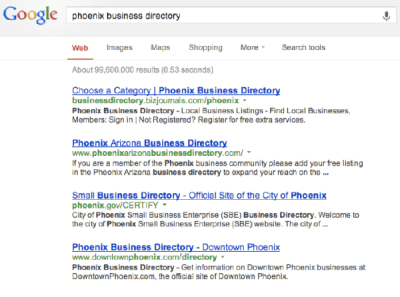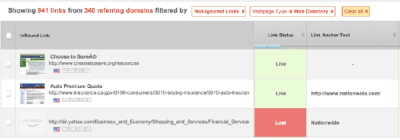If you want to make it easier for people to find your small business online, getting listed in online directories is a powerful way to help you do that. It’s also a good way to build your website’s domain authority, because directory listings will increase the number of backlinks to your website—helping you show higher in search results, which can ultimately bring in new leads for your small business. I’ve seen several small businesses grow significantly from spending an afternoon every few weeks on getting listings. So it’s a marketing strategy well worth investing in. As with all search engine optimization (SEO) strategies—especially link building—you have to be careful to make sure you are only adding your business to relevant, quality directories that will indeed improve your online visibility. I’ve developed the following three-step process to make sure you’re able to do just that.
Step 1: Find the Top Directories for Your Business
First off, let’s look at some ways you can discover good online directories to submit your business to. As you come across good directories, bookmark them or add them to a spreadsheet so you can keep track of them. The number of options will depend on your type of business, especially considering there are 222 million results when you search for web directory on Google. For this step, I suggest creating a list of 50 – 100 top directories to start with. Then we will discuss how to evaluate which ones make the most sense for you.
Industry Specific Directories
The best way to start is to find the highest ranked directories in your industry. For example, if you are a wedding photographer and you do a Google search for wedding photographers, the first two results (after local listings in some cases) are highly relevant industry directories.

Since these directories are likely getting a lot of traffic, they are ones you should consider adding your business to. You can also do Google searches for your industry + directory to find more highly relevant directories.

You can also find relevant directories by visiting Directory Critic and looking under applicable topics in the Niche Directory Lists section. Add these to your spreadsheet along with applicable information (like pricing) and continue.
Local Directories
If you have a local business, you will have an abundance of local directories to choose from. You can start with general local directories like Yelp, Merchant Circle, Yellow Pages, Yahoo Local, SuperPages, DexKnows, and Manta.
Then, you can move on to industry-specific local directories. Event planners, for example, can get listed at Eventective, Gathering Guide, and Punch Bowl. You can find more local directories by industry at Get Listed.
After that, you can move on to location-based directories. If you do a Google search for your city, state, or region plus directory or business directory, you’ll likely find a lot of good options.

Be on the lookout for directories maintained by local newspapers, the Chamber of Commerce, main city sites, and more. You can also find some good location-specific directories at Get Listed.
Directories Competitors Use
One good tactic for both visibility and link building is to make sure you are listed in the top directories that your competitors are listed in. The fastest way to find out where your competitors are listed is to analyze their backlink profile – the collection of incoming links to a competitor’s website. Tools like CognitiveSEO allow you to analyze your competitors’ backlinks and filter out backlinks from web directories.

You can also use their tool to sort your competitors’ backlinks by authority, that way you can see the best directories first. You can also use Google to discover the directories your competitors use by searching for their company name plus directory.

General Directories
After you’ve discovered some industry-specific, local, and competitor-used directories, you can move on to general directories. These are ones that simply allow most businesses to list themselves in a specific category. To find general directories that have a category for your business type, do a Google search for inurl:category directory.

This search will help you find both general directories with a category for your business as well as additional industry-specific directories. You can also refer to the general directories listed on Directory Critic. Some really good general directories include Yahoo, DirJournal, Best of the Web, DMOZ, and Joe Ant.
I’ll go into more detail in the next step on how to evaluate directories, but for now as you discover these general directories, I suggest making sure that they have a rigid approval process in place. Directories that allow anyone to submit a link without any rules (such as no online pharmacy, adult, or casino links) should be avoided. Otherwise, you could find your business listing next to something unsavory.
Customer Directories
Some service providers that you may be using to run your business may have directories where they list their customers for other customers to find. For example, Vistaprint has their own business directory for customers.
Alumni Directories
Links from universities are typically considered high authority. One way to get one is by checking to see if your alma mater has a business directory on their site—just do a Google search for your college name plus business directory. If so, let them know about your business and get listed! If your business has more than one owner, see if each owner can approach their own university to get multiple listings.
Certification Directories
If you or someone at your business has a particular certification, see if that site has a listing for certified experts. For example, you can get your business listed on Google if you are Google Analytics Certified Partner. And who wouldn’t want a link from Google.com itself?
Recommended Service Provider Directories
If you or someone at your business works with a particular product or service, see if that product or service lists recommended service providers. For example, if you are a web designer that works with customizing WordPress designs, you could get listed on pages like StudioPress Genesis Developers, Thesis Designers, or WooThemes Wooworkers. Or if you work with ecommerce platforms like Shopify, you could get listed on the Shopify Ecommerce Website Developerspage. So think about things you specialize in, and find out if they would list you on their site.
Step 2: Identify Quality Directories
Your next step is to narrow down your full list of possible directories to the ones that are worth your time and effort submitting to—namely the high quality directories that are safe for your business and that will help you dramatically increase your online visibility. If you’ve done a thorough search for directories, you will have turned up several you should definitely get listed in, as well as a handful you should not bother with. Here are some factors you can use to help you separate the top directories from the rest. I suggest trying to identify between 25 – 50 top directories.
- Does the directory get traffic? While it’s hard to get reliable information about the traffic a website receives, you can compare one website’s traffic to another by looking up the Alexa rank for each directory. Simply go to “http://www.alexa.com/siteinfo/directory.com” and change directory.com to the domain of the directory you are checking out. Add this information to your spreadsheet so you can analyze which ones are getting the most traffic. The lower the number, the higher the traffic. I recommend using this more as a comparison tool—if you see one directory has an Alexa ranking of 1,110 and another directory has an Alexa ranking of 9,500, then you know the first directory is going to be a better source of traffic than the second.
- Does the directory have rules about what types of website can or cannot be added? I mentioned this before, but I’ll mention this again. Quality directories will moderate what websites can be listed on their site, regardless of payment. Generally, you will want to look for directories that do not allow sites related to adult entertainment, online pharmacies, illegal content, etc. to be listed. If a directory has no rules about the types of websites it will include, avoid it.
- Does the category you are submitting to have relevant listings? Browse through the other website listings in your category before submitting to make sure they are relevant. While some directories have a list of rules, it doesn’t mean they always adhere to them.
- Does the directory have good rankings on Google? If you go to “http://www.semrush.com/info/directory.com” and replace directory.com with the domain of the directory you are considering, you should see a chart of the number of keywords the directory is ranking for. Ideally, the chart should always be steady or moving up. You can hover over the most recent measurement to see the number of keywords the directory ranks for. Note that thanks to Google’s latest algorithm changes, many directories have lost a lot of keyword rankings in search, but so long as general directories still have at minimum over a thousand keywords in search, they are still getting good search traffic.
- Can your business get on the first page of the relevant category? Just like being on the first page of search results, being on the first page of a relevant category within a directory will boost your chances of getting clicks through to your website. The first page is also usually the one with the highest authority. So try to aim for those that you can get on the first page of. Usually, this means going for a premium listing, or you can look at the number of listings on the first page of other categories (most show only 10 per page) and determine whether your listing would be in the first 10. Also note if the pages are alphabetically organized by default—if your business name starts with A, you’re more than likely going to stay on the first page. If it starts with Z, you might be better off with a premium listing that guarantees you the top spot.
Step 3: Submit to your selected directories
Now that you’ve narrowed your list down, it’s time to submit to your chosen directories. The following tips will help you get the most out of your directory submissions and make submitting easier.
Create a Template
Directory submissions can be a time-consuming process. You can expedite this process by creating a template for your directory submissions that includes the standard information that most directories require including the following.
- Website Title – This is what your website URL will link to, also known as your anchor text. Some directories are specific about only allowing you to use your business name, while others will allow you to use keyword-optimized anchor text. It’s best to use your business name as Google has started penalizing websites in search results due to the overuse of keyword-optimized anchor text.
- Website URL – Most directories want you to use the URL for your homepage.
- Website Description – Generally one to two sentences about your business. Follow the instructions on the submission form as many specify the length to aim for.
- Your Contact Information – Name, email address, mailing address, and phone number.
- Meta Keywords – These are the main keywords for your business. Some directories will ask for this because they will optimize your listing page for these keywords.
- Meta Description – This should be your business’s main description, shortened to 160 characters or less.
- Deep Links – Some directories allow you to add additional links to your listing. These links should point to the top pages on your site that you would want visitors to see, i.e. your products and services pages. Include a website title, URL, and description for your top five deep links in your template.
Randomize Your Anchor Text
Google has been vigilant about penalizing sites that heavily use over-optimized keyword anchor text in their link building. Therefore, you don’t want every link to your website pointing to web designer. As a matter of fact, you don’t even need to use keyword anchor text in most cases if you are getting listed on a directory page that is specific to your business, i.e. having your business listed under the category for web designers
As you’re creating your directory submission template, be sure to include several different website titles/anchor text for your link such as your business name plus different variations of the keyword phrases you are targeting. This way, you will have different options to choose from as you go from one directory to the next, based on each directory’s rules.
Search for Coupon Codes
Lots of directories provide coupon codes. Before you submit, do a quick Google search for the directory name plus coupon code or discount code. It never hurts to try a few, and it could save you a lot in the long run.
Aim for First Page Listings
As mentioned earlier, you will want to choose the listing that gets your business on the first page of the relevant category if possible. By doing this, you won’t have to rely on using keyword-optimized anchor text for the link to your website as your link will be on a page that is already keyword-optimized for your business, such as submitting your web design business to a directory in the web design category.
Check to See When Your Link is Posted
Some, but not all directories will notify you when your link is posted. You will want to keep track of all of the places you submit your business to and check back to make sure your link was added. If not, you will need to follow-up with the directory owner or editors. You can monitor this manually by adding the URL for the category you submit your business to a spreadsheet, or use link building tools that help you manage and monitor your links.
Pace Yourself
You really don’t want to go from zero links to 1,000 in one week. Slowly build up quality directory links while working on building links from other sources such as blogs, partner businesses, and social media. You could for example, aim to add 5 directory listings every couple of weeks. It’s a manageable number that will not stand out to Google as an unnatural amount of link growth.
Don’t Only Attain Directory Links
While directories are easy links to acquire, you shouldn’t only focus on directories. A natural link building profile consists of different types of links: blogs, other businesses, social sites, media, and so forth. Directories should be a part of your link building strategy, but it shouldn’t be 100% of your link building strategy.
Now that we’ve covered off the three-step process for getting quality listings in online directories, I want to suggest that you also consider getting listed in offline directories.
Submit to Offline Directories
Believe it or not, some people still hire businesses they find in physical directories and listings, so they can certainly be a good source of leads for you. Depending on your location, your industry, and whether you have a local business, you may find lots of offline listing opportunities beyond the phone book. These can include freebie guides or magazines (like the ones you find at gas stations), local or national magazine publications (check out your local bookstore), and booklets.
One way to discover good places to list is by visiting your competitors’ websites. If they have a listing in a valuable source, they might brag about it on their website, usually on the about page, media page, or “featured on” page.
Also, if you’re looking for local offline directories, you may be able to get help by visiting your Chamber of Commerce or Small Business Administration office. They can probably steer you in the right direction.
In Conclusion
There are tons of ways to discover great directories to gain visibility for your business. Have you seen success from submitting your business website to online or offline directories? If so, please share your experience in the comments!
Editor’s note: This story originally appeared here.




